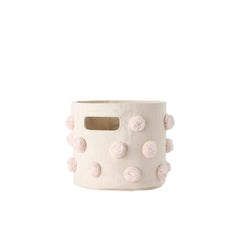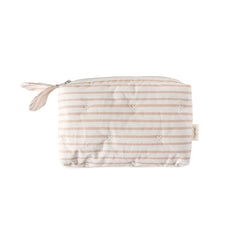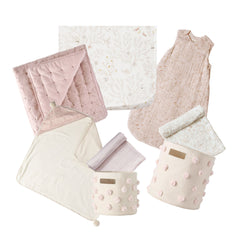Sleep is top of mind for many newborn parents, especially on days when it’s in low supply. When it comes to establishing healthy sleep habits for your little one, routines, schedules & rituals can be extremely helpful. The good news is that you can start establishing these routines by the time your baby turns one month. If you’re wondering how to create the right one-month-old sleep schedule for your little one, you’ve come to the right place! This article will walk you through why sleep schedules are so important, how to leverage the concept of wake windows to establish a routine for your baby, a one-month-old sleep schedule you can try out, and, finally, some tips and tricks to help you and your little one stick to your established routine. More sleep is on the way!
Table of Contents
- Why are sleep schedules important?
- What is a wake window?
- One-month-old sleep schedule
- Tips and tricks for sticking to your one-month-old sleep schedule
Why are sleep schedules important?
Getting into a predictable daily rhythm early on in your baby’s life can help set them up for healthy sleep and feeding habits for years to come. While a newborn does not need to be on a strict schedule, it’s a good idea to start to introduce some structure to sleep and feeding routines by the time your baby turns one month old. A great place to start is being mindful of wake windows.

What is a wake window?
Wake windows are a helpful way to structure your one-month-old sleep schedule. If you don’t know what a wake window is, we have good news: the concept is very simple. A wake window is simply the amount of time that your baby stays awake between sleep periods. Many parents structure their little one’s day around consistent baby wake windows. The length of these waking periods changes as your child gets older but the concept remains the same.
We recommend marking the beginning of your child’s wake period as the time they get out of their bed, crib, or bassinet. You can mark the end of the wake period as the time you put them down for their next nap even if they don’t fall asleep right away.
Wake windows can be a very helpful tool in structuring healthy sleep habits for your newborn. Establishing and sticking to a consistent period of waking time between naps can be very helpful in maintaining a healthy routine and may even result in longer and better sleep for your child. If you’re curious about why wake windows work so well, the theory is that consistent age-appropriate wake windows ensure that your little one does not get overtired. When you start to feel tired but choose to stay up, your body releases a series of hormones to try and combat the fatigue. These hormones are responsible for the ‘second wave’ of energy we sometimes get after we experience fatigue. The same thing happens to your little one if they stay awake for too long. This is why wake periods for babies are so important. They prevent your little one from becoming so overtired that they’re unable to sleep when it’s time to go down for a nap.
One-month-old sleep schedule
Before you dive into establishing nighttime rituals and sleep schedules with your newborn, start with a little bit of research and observation. Keep a sleep log to track how long your baby is sleeping each time you put them down at night, how long naps are, how much time you are taking between feedings, and how long your little one is awake between naps. Take note of sleep and feeding routines on days where your child seemed especially fussy and on days where your child was exceptionally easy to put down.
Newborns need a lot of sleep to give their bodies the rest they need to maintain healthy growth and development. Additionally, their new surroundings are highly stimulating and they are absorbing a lot of new information when they are awake. So, it’s best to keep the time between naps short for your little one so they don’t get overwhelmed or overtired. When building a one-month-old sleep schedule we recommend sticking to 45 minutes - 1 hour wake windows.

With all this in mind, here is an example of a one-month-old sleep schedule that might work well.
|
Time |
Activity |
|
7 AM |
Wake & Feed |
|
Wake Window |
|
|
8 AM |
Nap |
|
9 AM |
Wake & Feed |
|
Wake Window |
|
|
10 AM |
Nap |
|
Noon |
Wake & Feed |
|
Wake Window |
|
|
1:00 PM |
Nap |
|
2:00 PM |
Wake & Feed |
|
Wake Window |
|
|
3:00 PM |
Nap |
|
5:00 PM |
Wake & Feed |
|
Wake Window |
|
|
6:00 PM |
Nap |
|
7:00 PM |
Wake & Feed |
|
Wake Window |
|
|
7:30 PM |
Bedtime |

Tips and tricks for sticking to your one-month-old sleep schedule
Now that you’ve established a one-month-old sleep schedule, how can you stay on track with it?
- Start at the right time. You can start introducing routines into your little one’s day at around the one-month mark. But, as is the case with so many things in parenting, this is not a one-size-fits-all start date. If your baby is not ready for more structure it could simply be a sign that now is not the right time to try and introduce a more strict routine to your baby’s day. Give it a week or two and then try again!
- Be flexible with a newborn. Once your baby is starting to settle into a new rhythm it’s important to be flexible. This is especially true if your baby is only one or two months old. It’s ok to let your little one’s natural rhythms take precedence over a timeline or schedule.
- Learn your baby’s sleep cues. One of the best ways to find the balance between a sleep schedule and your baby’s natural rhythms is to learn and pay attention to your child’s sleep cues. If you notice your baby has lost interest in their toys, is yawning, rubbing their eyes, or pulling at their ears, these are all signs that your baby is becoming tired. It’s best to get them down for a nap before they become overtired and fussy.
- Establish bedtime and naptime routines. It doesn’t matter if you’re an adult, a newborn, or a toddler, a bedtime routine is a great way to help your body begin to unwind and prepare for sleep. That’s why it’s helpful to get your child started with some nightly rituals and routines early in life.
- Adjust as your baby grows. A routine that works well for your one-month-old, is probably not going to be ideal for a six-month-old so make sure your daily routine evolves as your baby develops.
- Take care of yourself. Remember, you can’t pour from an empty cup and babies can be incredibly tuned into the emotions and energy of their parents. So, make sure that, as you develop a healthy routine for your little one, you’re also working on one for yourself!
The first month at home with your little one is a magical time filled with exciting firsts and beautiful milestones. But, it can also be quite an exhausting few weeks for new parents. The good news is that by the one-month mark, your little one is ready for some structure and routine which means you can also reintroduce a little structure and routine to your day! You and your little one find your rhythm (and more opportunities for sleep!) in no time.






